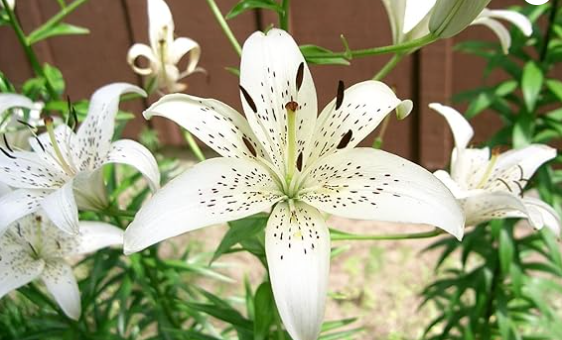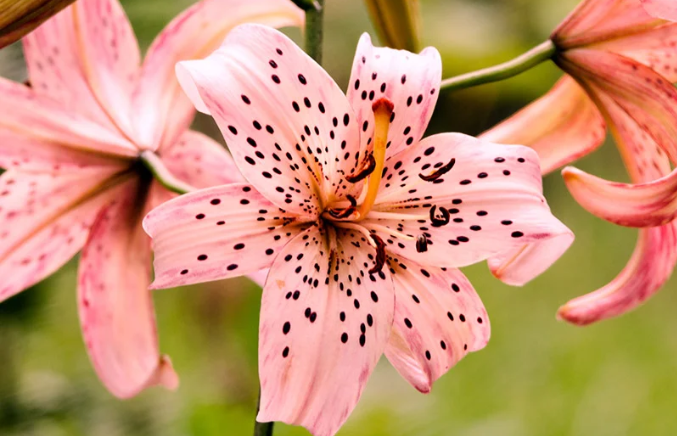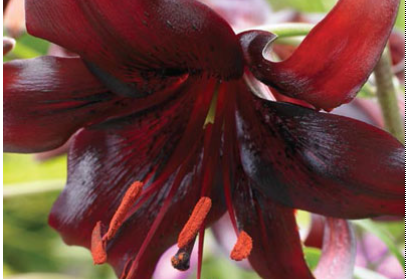
The Tiger Lily, also known as Lilium lancifolium or L. tigrinum, is a flowering plant belonging to the genus Lilium. Native to China, Japan, and Korea, this perennial has a bright orange flowers covered with black or deep crimson spots, resembling the skin of a tiger. It is considered a hybrid because it has not been found growing wild in its native lands. In 2002, the tiger lily won The Royal Horticultural Society’s Award of Garden Merit.
Tiger lilies are bulbous perennials. They will come back year after year if properly cared for. These 3- to 4-foot-tall flowers grow well in U.S. Department of Agriculture plant hardiness zones 4 through 9. They produce hairy stems covered with green, lance-shaped leaves and midsummer blooms with petals that curl backwards. The flowers are bright orange with black spots. Mature tiger lily bulbs can develop at least ten 2-inch-wide flowers each summer.
Tiger lilies prefer full sun to partial shade and well-draining, rich soil. They are relatively low maintenance and can be planted in either spring or fall. These plants are drought-tolerant but still require regular watering, especially during dry periods. An application of compost around the base of the plants each year in the spring provides all the nutrition they need as their bulbs form clumps throughout the garden bed.
The bright orange flowers offer the gardener a beautiful cut flower, which lasts up to two weeks in a vase. Tiger lilies grow well with other perennials in flower borders, gardens and containers. The tall height of the tiger lily flower stalks creates a vertical texture that looks visually pleasing in front of shrubs. When caring for tiger lilies, cut back the foliage after the first frost, which helps them overwinter successfully.
Tiger Lily Plant Propagation
Propagation From Divisions
- Divide tiger lilies in autumn after the foliage dies back completely. Cut back the stems to 3 inches, using pruning shears to make lifting the bulbs easier.
- Measure out 4 inches around the tiger lily bulbs. Dig an 8-inch-deep trench around the bulbs. Work the tines of a spading fork underneath the bulbs and gently pry them up.
- Remove any thick pieces of soil that are caked onto the bulbs. Gently brush the remaining soil away using a paintbrush. Set the bulbs in a shady place while preparing the planting site.
- Prepare a new planting site for the tiger lily bulbs or revitalize their previous bed. Weed the planting site and work a 5-inch layer of compost into the top 12 inches of soil.
- Divide the stem bulblets from the main bulb. Sever the bulblets where they attach to the main bulb using a clean, sharp gardening knife. Discard any bulbs or bulblets that appear pest-damaged or dried out.
- Transplant the divided bulbs and bulblets into the prepared planting site. Plant the small bulblets at a depth of 3 inches and the larger bulbs at a depth of 5 inches. Space them 12 inches apart.
- Water the tiger lily bulbs to a depth of 5 inches after planting. Provide supplemental water during the winter months only if no rain falls for longer than one week. Watch for renewed growth in late spring.
Propagation from Bulbils
- Propagate tiger lilies from bulbils in early autumn before the foliage dies back completely. Prepare a planting site before detaching the bulbils from the parent plant.
- Prepare a sunny or very lightly shaded area for the bulbils. Weed and break up the soil to a depth of 12 inches. Remove any large pieces debris from the soil. Work a 5-inch-thick layer of compost into the bed.
- Create 4-inch-deep furrows in the prepared planting site. Pull off the small, shiny black bulbils from the base of the leaves. Plant them 8 inches apart in the furrows and cover them with the amended soil.
- Water the bulbils to a depth of 5 inches after planting. Provide water during the winter months if no rain falls for longer than one week. Avoid overwatering since the bulbils will rot.
- Water regularly during the spring and summer months. Keep the soil barely moist in the top 2 inches. Decrease watering in autumn and winter unless the weather is dry.
- Dig up and transplant the bulbils into a permanent bed in autumn of the following year. Space them 12 inches apart at a depth of 3 inches. Care for them as you would tiger lily bulbs and watch for aerial growth the following spring.
Planting and Care
- Sunlight: Tiger lilies prefer full sun but can tolerate some partial shade.
- Soil: They thrive in well-draining, slightly acidic soil. Amending your planting bed with compost or aged manure before planting is beneficial.
- Planting: The best time to plant tiger lilies is in spring or fall. Dig holes deep enough to accommodate the bulbs and space them 3 feet apart as they will spread over time.
- Watering: Water regularly, especially during the first growing season, to maintain consistently moist soil. Established plants are more drought tolerant but will appreciate extra watering during extended dry periods.
- Fertilizing: Generally not necessary, especially if your soil is rich in organic matter. However, a balanced fertilizer in early spring can be applied if the foliage looks pale.
Common Problems Associated With Growing Tiger Lily
- Overwatering: Tiger lilies prefer well-draining soil. Overwatering can lead to bulb rot, which is a common problem. The soil should be moist but not waterlogged.
- Pests: Tiger lilies are susceptible to pests like aphids, red lily beetles, and lily mosaic virus. These can distort the leaves and eventually kill the plant if not treated promptly.
- Poor Soil Conditions: Tiger lilies prefer slightly acidic soil with a pH between 5.5 and 6.5. They need rich, well-draining soil to thrive. Poor soil conditions can lead to stunted growth or failure to bloom.
- Inadequate Sunlight: Tiger lilies need at least six hours of sunlight a day. They can grow in partial shade, but too much shade can result in fewer blooms and a weaker plant.
- Temperature Fluctuations: Tiger lilies are hardy in USDA Hardiness Zones 3 through 9, meaning they can tolerate a range of temperatures. However, extreme temperature fluctuations can cause stress to the plant.
- Spacing Issues: Tiger lilies can grow up to 4 feet tall and spread up to 1 to 2 feet wide. If they are planted too close together, they can compete for resources, leading to stunted growth and fewer blooms.
Major Cultivars of Tiger Lily
Flore Pleno (Double Tiger Lily)

This cultivar features double flowers with layers of orange petals adorned with dark spots.
White Tiger

This elegant cultivar has pure white flowers with a smattering of maroon spots.
Yellow Tiger

This cultivar bears bright yellow flowers with dark brown spots.
Pink Tiger

This cultivar has delicate pink flowers with dark spots.
Tigrinum Splendens

This cultivar produces a profusion of bright orange flowers with dark maroon spots.
Tiger Babies

This cultivar produces a multitude of smaller, orange flowers with dark spots.
Red Velvet

This cultivar has deep red flowers with dark brown spots.
Night Flyer

This cultivar features dark red flowers with a nearly black center and prominent maroon spots.
Pink Flight

This cultivar has a soft pink flowers with a scattering of maroon spots.
White Twinkle

This cultivar produces pristine white flowers with a smattering of dark spots.